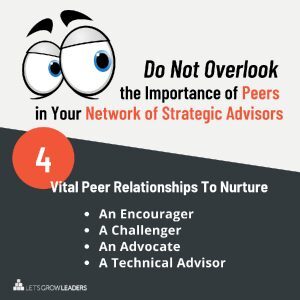David Dye's Blog, page 55
January 9, 2022
Asking For a Friend 2021 Highlights Part 2
Karin Hurt shares highlights from the 2021 season of Asking for a Friend Live. With thought leaders sharing insights about how to show up as a confident, courageous, and trusted leader.
This is part 2 of Asking for a Friend 2021. If you missed part one you can view that here.
The post Asking For a Friend 2021 Highlights Part 2 appeared first on Let's Grow Leaders.
January 7, 2022
3 Overused Strengths that Will Limit Your Leadership
oYou work hard to set a positive example for your team. You care about success, and you want your people to succeed. You’ve clarified what matters most and you’re committed to accountability. You’re intentional about your culture. But somehow, your leadership presence isn’t working. You don’t have the connection or influence you hope for. Committed, caring, hard-working leaders often find one or more of three overused strengths interfere with their influence.
If any of these issues sound familiar, you can readily overcome them with a few straightforward solutions you’ll get in this episode.
1:00 – When your leadership presence isn’t working, you don’t have the connection or influence you hope.
1:27 – The first overused strength that can limit your leadership is tunnel vision. Focus is helpful, but become too focused and you miss out on relationships, perspective, and critical elements of the work.
2:20 – The antidote to tunnel vision.
3:00 – The second of the overused strengths that can become a problem is emotional splash. This is the unproductive drama, negativity, frustration, and stress that you can unintentionally dump on your team. Intensity is a strength, but one that we must manage.
4:52 – The antidote to emotional splash.
6:47 – The third overused strength to be aware of is toxic positivity. Optimism is at the heart of leadership – the belief that together we can have a better tomorrow. But toxic positivity takes this optimism too far and insists on positivity and excludes the range of other emotions like grief, frustration, or languishing.
7:50 – Antidotes to toxic positivity.
10:55 – Leave a rating, share the show with leaders in your life, and submit your question for a future episode: LeadershipWithoutLosingYourSoul.com
The post 3 Overused Strengths that Will Limit Your Leadership appeared first on Let's Grow Leaders.
January 3, 2022
3 Leadership Values to Encourage in Every Member of Your Team
During difficult times, what leadership values matter most? We’ve been asking this question of the leaders we work with around the world. Consistently, compassion, courage, and curiosity continue to top the list, closely followed by flexibility and authenticity.
In fact, in our recent LinkedIn poll, 61% said “compassion” was most the most critical leadership value this year.
Why these three leadership values? Why now?
When people are scared and uncertain, they want to know they’re not alone. They long to know that people care about them for who they are, not just what they can contribute. And they want to hope for a brighter future—that’s where courage and curiosity can help your team to thrive.
Of course, these leadership values are not just for people leaders.
Imagine what would happen if every member of your team showed up 10% more compassionate, courageous, and curious this week.
3 Leadership Values to Nurture on Your TeamSo today, we’re sharing practical ways to nurture these leadership values on your team.
1. CompassionIn a recent Asking for a Friend interview about compassionate accountability, Dr. Nate Regier takes us back to the root of the word compassion: “to struggle with.” What a great way to think about building a compassionate team. On this team, we struggle together. My challenges are your challenges, and we’re all here to help.
We’re also seeing compassion showing up more frequently in formalized company values.
We asked Joe Liberatore, Kforce’s CEO why compassion was so critical in the recent refresh of their company values. He says:
Lifting up the core value of Compassion in a time of such seismic change where life/work balance are being recalibrated, fosters a laser focus on the empathy and care required to support the wellbeing of our people that are the heart of our business.
So, where do you start in order to nurture compassion?
First, help your team put people before projects. Give them the space to know and learn about one another and the challenges they’re facing at work and in their lives. You can’t “struggle with” someone if you can’t see their pain.
Your diversity, equity, and inclusion efforts are a good start. And, teaching every member of your team some straightforward techniques like “reflect to connect,” can really help.
We call this process of acknowledging emotion “reflect to connect” because you are reflecting the emotion you observed and making sure you understand what’s on their mind.
For example: “It sounds like you’re really frustrated with the lack of response from marketing and that’s sapping your motivation. Do I have that right?”
Note: you’re not telling them that their feelings are right or wrong. When you reflect, you are checking for understanding and creating a common starting place for the conversation. Most people struggle to collaborate or solve problems when they don’t feel understood or seen.
2. CourageIn our research for our book, Courageous Cultures, we asked employees to share “their biggest moment of courage at work.” Do you know what’s interesting? Most of the actions were not what most of us would label as remarkably courageous, like whistleblowing or confronting a #MeToo situation.
Most of these self-declared courageous acts involved staying true to a value and speaking up for what was right.
One of the most practical ways to help your team grow in the leadership value of courage is to help them develop their voice. The irony of a courageous team is that it takes less daily courage to speak up on behalf of one another, a process, or the customer because it’s just what people do.
As a start, give your team deeper skills to …
Speak up in meetingsHold accountability conversationsGive feedback to you (or your boss)Invite feedback from othersAs your team practices speaking up, they won’t always do it elegantly or accurately. That’s okay. Embrace the awkwardness of the transition. Celebrate effort – especially when someone takes a risk of challenging one of your ideas.
3. CuriosityThis leadership value is vital right now as we rebuild our infrastructure, tools, and processes for the future of work. Be sure your team has the tools to ask meaningful questions that will surface strategic solutions and that they know how to share their ideas.
Here are a few places where you and your team can get curious:
Better ways to accomplish your strategic prioritiesHow to work more effectively in their hybrid and virtual teamsRoadblocks getting in their wayHow they can better leverage their strengths to help the teamYour TurnOf course, these leadership values are not the only ones we need, but they’re a good start. We would love to hear your thoughts and approach. What will you do to help your team be more compassionate, courageous, and curious this year?
The post 3 Leadership Values to Encourage in Every Member of Your Team appeared first on Let's Grow Leaders.
January 1, 2022
Asking for a Friend 2021 Video Highlights (Part 1)
Thanks to all of you who have joined our Asking for a Friend community this year! I’m so grateful for all the authors, executives and all of you human-centered leaders joining the conversation. So many great insights about the future of work and leading well through times of uncertainty and change.
Remote work and hybrid teams are here to staySo important to capture all we’ve learned and apply it to the future of workConnection matters now more than everLeverage the learning from virtual training– lot’s of insights on how to deliver high-ROI leadership trainingBe patient with yourself– extend the same grace to yourself as you give to othersSavor the momentsAnd more.Our executive producer, Jared Herr, has done a fabulous job sharing highlights from our live shows in three parts.
Here’s the first of three Asking for a Friend 2021 Highlights. You might also enjoy our 2021 Best Leadership Articles of the Year (Based on Your Votes)
Do you have a tough leadership question you’re grappling with? Please leave it in the comments below. I’m always looking for new Asking for a Friend questions to answer.
The post Asking for a Friend 2021 Video Highlights (Part 1) appeared first on Let's Grow Leaders.
December 27, 2021
The Best Leadership Articles of 2021 (according to you)
Every year we take a really close look at our human-centered, practical leadership content that is resonating with you. And, use that insight to help us plan for what would serve you most in the new year. These are your favorite leadership articles of 2021 based on views and shares. Click on the headlines or pictures for links.
As we continue to support you and your teams in your human-centered leadership journey, we would love to hear from you. What was your favorite article of the year? Why?
What leadership articles would you like us to write about more in the coming year?
1. How to Provide More Meaningful Performance FeedbackMost employees yearn for more meaningful performance feedback—and are just not getting enough.
This leadership post covers some of the most popular performance feedback tools and techniques that we teach in our leadership development programs.
2. The Blight of Soul-Crushing Useless Negative Feedback
Unfortunately, negative feedback is destructive and all-too-common. Our second most popular leadership article covers how to prevent senseless feedback from zapping your team’s motivation.
3. End-of-Year Meeting: How to Make Yours Remarkable
Okay so technically this one is from December 2020, but it’s been so popular this year, we want to ensure you don’t miss it. Also, popular is this guide to virtual kick-off meetings.
4. Get Your Team Back on Track – Leading Through Distractions Human-centered leadership work is always challenged by distractions. And this year, we know you and our team have had plenty of important challenges that made it even more difficult than usual to focus. This popular leadership article provides practice tips for keeping your team on track. And, if you find this article helpful, you might also enjoy this Asking for a Friend about empowering your team during times of uncertainty.5. How to Deal with Team Conflict
Human-centered leadership work is always challenged by distractions. And this year, we know you and our team have had plenty of important challenges that made it even more difficult than usual to focus. This popular leadership article provides practice tips for keeping your team on track. And, if you find this article helpful, you might also enjoy this Asking for a Friend about empowering your team during times of uncertainty.5. How to Deal with Team Conflict
 This popular leadership article provides six ways to deal with team conflict. And if you find this helpful, you might also like to learn how to surface conflict, so it can be addressed before it erupts.6. A Manager’s Guide to Better Decision Making
This popular leadership article provides six ways to deal with team conflict. And if you find this helpful, you might also like to learn how to surface conflict, so it can be addressed before it erupts.6. A Manager’s Guide to Better Decision Making
 This guide contains very practical tips for making better decisions and can help gain back lost time.7. How to Give Your Team the Energy They Need
This guide contains very practical tips for making better decisions and can help gain back lost time.7. How to Give Your Team the Energy They Need In one of our earliest leadership articles of 2021, David shares practical ways to give your team more energy and hope.8. How to Build a Better Network of Peer Relationships
In one of our earliest leadership articles of 2021, David shares practical ways to give your team more energy and hope.8. How to Build a Better Network of Peer Relationships
 This extremely popular article also includes a practical tool you can use to build a better network of peer relationships.And….. Our Most Popular Leadership Article of All Time 7 Ways to Help Your Team Deal with Ambiguity, continues to be our most popular article by a landslide. We would love for you to help keep the conversation going and leave a comment on your favorite leadership tip for dealing with ambiguity and change.The Best Leadership Article Published Elsewhere (Training Magazine)
This extremely popular article also includes a practical tool you can use to build a better network of peer relationships.And….. Our Most Popular Leadership Article of All Time 7 Ways to Help Your Team Deal with Ambiguity, continues to be our most popular article by a landslide. We would love for you to help keep the conversation going and leave a comment on your favorite leadership tip for dealing with ambiguity and change.The Best Leadership Article Published Elsewhere (Training Magazine)People seemed to really resonate with our article in Training Magazine, Building Teams that Speak Up and Solve Problems
Leadership without Losing Your Soul Podcast (With David Dye)Most Popular Podcast Interview: Building a Human-Centered Culture- With Charlie Bailes
You build your culture one decision at a time—but how do you ensure that the decisions you make build the culture you want? In this episode, Charlie Bailes, VP of Human Resources and Distribution for ABC Fine Wine and Spirits shares practical ways you can build a human-centered culture in your organization, team, or department.
Most Popular “How To” Episode: Unleash Your Team’s Best Thinking
Have you ever watched a team member do something clever, solve a problem, or creatively improve a process, then ask them why they hadn’t shared it with the team? Too often, your team’s best thinking remains hidden.
Karin’s Asking for a Friend show continues to gain traction. Her most popular interview was with Liz Wiseman.
Liz Wiseman’s book is based on research conducted with a variety of companies including Adobe, LinkedIn, and SAP, to determine what behaviors affect someone’s influence at work.
And the most popular show-on-the-road was “What Do I Do if My Team Doesn’t Like Me?” (with scenes from Yellowstone Park).
And in case you’re looking for more popular leadership articles, you can find the Best Leadership Articles of 2020 here.
Your turn, what were one or two of your favorite leadership articles of 2021. What would you like to read more about in 2022? Please leave a note in the comments.
The post The Best Leadership Articles of 2021 (according to you) appeared first on Let's Grow Leaders.
December 22, 2021
How Reading Body Language Can Make You a Better Leader (With Video)
When Connecting With Your Team
As a human-centered leader, you want to pay attention to what’s really going on with your team. Understanding body language can help you know where you can, and should, probe a bit deeper to see how you can help.
In today’s Asking For a Friend, I talk with body language expert, Traci Brown as we answer “What body language secrets hiding in plain sight will make me a better leader?”
Body Language Insights From Traci Brown3:30 Watching body language and knowing more than is immediately obvious will help you be a better leader.3:55 Traci shares some of her favorite cases.
7:05 Body language secrets should leaders be on the lookout for in order to understand what is going on with their people.Facial expressions and tones when you ask them about their stress level.Trends and changes in tone, patience, and engagementRemember that body language, tone, and words intersect in deception detection.10:00 Some specific body language examplesNodding while saying “I would never do that.”Veiled sweetnessShaking head while agreeing.Open hands – these tend to let you know that people are sharing their truth (even if it’s not THE truth)Disappearing hands should prompt you to dig for more info17:45 Are there differences in online/remote interactions or with those wearing masks?Reading someone online works the same as reading in person.Pay attention to what you CAN see.There are messages in everything (i.e. when someone wants to keep their camera off.)Look for pleasure/displeasure.Rolling lips in can mean holding back emotions or information.Pursed lips often mean silent disagreement.Eyebrows going down can mean anger.Eyebrows up can be sadness.One eyebrow up can be skepticism.Showing the whites of the eyes can mean fear.Emotions are not bad. They are an invitation to go deeper into the conversation.
19:55 What are good ways to learn body language to improve your own?Is someone telling you that you have a problem?Quick hacks will not work. You will come across as incongruent.Long-term, you can improve. Practice matching/mirroring. We are hard-wired to follow others. People buy from people like them.24:00 How do you watch emotions while also looking at the camera?Remember that everyone on the call is going through the same problem, so prioritize looking at people’s faces. We tend to only look at people in the eye 60% of the time normally. On video, we are looking for an extended period of time, which leads to fatigue. Give people in the meeting a break.
Your eyes should be in the top third of the screen on video. For anything dramatic, it’s okay to let the top of your head be cut off a little. Conversely, sitting back and having your face in the bottom quadrant appears less powerful.
28:50 How to stay in touch with Traci Text LIES to 2282830:00 Last bit of advice: Pay attention differently. It’s worth taking the time.The post How Reading Body Language Can Make You a Better Leader (With Video) appeared first on Let's Grow Leaders.
How Reading Body Language Can Make You a Better Leader? (With Video)
When Connecting With Your Team
As a human-centered leader, you want to pay attention to what’s really going on with your team. Understanding body language can help you know where you can, and should, probe a bit deeper to see how you can help.
In today’s Asking For a Friend, I talk with body language expert, Traci Brown as we answer “What body language secrets hiding in plain sight will make me a better leader?”
Body Language Insights From Traci Brown3:30 Watching body language and knowing more than is immediately obvious will help you be a better leader.3:55 Traci shares some of her favorite cases.
7:05 Body language secretes should leaders be on the lookout for in order to understand what is going on with their people.Facial expressions and tones when you ask them about their stress level.Trends and changes in tone, patience, and engagementRemember that body language, tone, and words intersect in deception detection.10:00 Some specific body language examplesNodding while saying “I would never do that.”Veiled sweetnessShaking head while agreeing.Open hands – these tend to let you know that people are sharing their truth (even if it’s not THE truth)Disappearing hands should prompt you to dig for more info17:45 Are there differences in online/remote interactions or with those wearing masks?Reading someone online works the same as reading in person.Pay attention to what you CAN see.There are messages in everything (i.e. when someone wants to keep their camera off.)Look for pleasure/displeasure.Rolling lips in can mean holding back emotions or information.Pursed lips often mean silent disagreement.Eyebrows going down can mean anger.Eyebrows up can be sadness.One eyebrow up can be skepticism.Showing the whites of the eyes can mean fear.Emotions are not bad. They are an invitation to go deeper into the conversation.
19:55 What are good ways to learn body language to improve your own?Is someone telling you that you have a problem?Quick hacks will not work. You will come across as incongruent.Long-term, you can improve. Practice matching/mirroring. We are hard-wired to follow others. People buy from people like them.24:00 How do you watch emotions while also looking at the camera?Remember that everyone on the call is going through the same problem, so prioritize looking at people’s faces. We tend to only look at people in the eye 60% of the time normally. On video, we are looking for an extended period of time, which leads to fatigue. Give people in the meeting a break.
Your eyes should be in the top third of the screen on video. For anything dramatic, it’s okay to let the top of your head be cut off a little. Conversely, sitting back and having your face in the bottom quadrant appears less powerful.
28:50 How to stay in touch with Traci Text LIES to 2282830:00 Last bit of advice: Pay attention differently. It’s worth taking the time.The post How Reading Body Language Can Make You a Better Leader? (With Video) appeared first on Let's Grow Leaders.
December 17, 2021
How to Reset Performance Expectations for Better Results
Outstanding performance starts with clear performance expectations—a shared understanding of what success looks like. But what do you do when a critical player on your team is doing “okay,” but not great?
Or, perhaps you’ve relaxed your performance expectations because of all the stress and strain of this crazy year, but now the lower bar has become the new normal.
The new year is the perfect time to reset and refresh performance expectations.
“But they SHOULD know better!”We’ve heard this sentiment from so many managers. They’ve hired an experienced player for a pivotal role. They’re frustrated because “They SHOULD’NT have to explain their job to them.”
We get it. Maybe you shouldn’t have to. But, if you’re not getting the results you need, and, you haven’t made your expectations perfectly clear, it’s unlikely much will change.
Start Here to Reset Performance Expectations1. Have them describe their vision of success.An easy way to begin the conversation is to start with their vision for the role. Be sure you’re talking about more than numbers. Also, take the conversation a level deeper to talk about behaviors.
For example, success might look like achieving quota, gaining market share, or completing a major project. Be sure you’re aligned there. Ask them to share their MIT strategic priorities. And then, probe to understand the initiatives and behaviors they think are necessary to make that happen.
The disconnect around performance expectations often comes at the behavioral level.

For example, they KNOW they need to achieve quota. But they might not understand your expectation to spend 50% of their time riding along with their sales team helping them establish deeper, strategic relationships with key decision-makers.
Some prompts:
What are your most important strategic priorities for the fourth quarter (or, if they’ve been through our leadership programs, you can ask “What’s your MIT?”)How are you planning to organize your week? What important activities are most critical to your success? How will you ensure you will have time for those?What strategic relationships do you need to invest in to really “up your game” in the new year?(And if they’re a people manager) Let’s talk about your team. What does success look like for _________ (yes, go role by role). What support do they need to be successful?2. Share your observations.Once you hear their vision, you’ll have a good sense of if they get it. If performance expectations (and the path to achieve them) are perfectly clear, then then it’s time for an accountability conversation. What have you noticed that’s different from the vision? Yes, an I.N.S.P.I.R.E. or A.R.T. of accountability approach will help here.
And, if their vision of what success looks like is different from yours, it’s time to reset expectations.
For example, perhaps you think they SHOULD know that building trusting relationships with their co-workers matters. But if you have not clarified that creating a high-performing team culture is a strategic priority, it’s not fair to expect them to prioritize that effort.
A note here. If you’ve never been explicit about a specific performance expectation, this is an opportunity to build deeper trust and collaboration. Own it (even if you think they SHOULD have known). Something like, “I know we haven’t talked about this much before, but success in this role is that you will be a role model for your peers in managing conflict. As one of our most experienced team members, I need your help in rising above the drama and helping me get this team working together.”
3. Discuss obstacles and roadblocks.It’s likely they’re as frustrated as you. No one wakes up in the morning choosing mediocre performance.
Ask (and really listen to) what’s getting in the way. If they’re stuck in the minutia, why? If they’re working long hours and still not accomplishing their most important things, how are they spending their time?
If they’re a people manager do they need to reset performance expectations for their own team? Do they need help, planning, and holding a courageous performance conversation (see also how to be a more courageous manager).
Do they need more resources, or to learn additional techniques for being more resourceful?
 4. Have them turn the conversation into a practical plan.
4. Have them turn the conversation into a practical plan.One big mistake we often see in these conversations is that it all SOUNDS good. You think you’re aligned, but nothing changes. Have them write what success looks like for the next 90 days in terms of tangible results, practical activities, and behaviors—and how they will measure success.
For example, if the expectation is 50% of the time spent with their sales team building strategic relationships, write that specific goal, and ask them to track it. This might feel like micro-managing, but it’s all in the delivery.
“I really care about you and your success. And if we both agree that the key to that success is time with your team building trusted customer relationships, let’s track that for a quarter and see how that’s working and if anything is getting in the way.”
5. Schedule the finish with a calendar appointment.If you have natural one-on-ones or quarterly meetings built into your communication cadence, pick one where you’ll revisit these refreshed performance expectations again. Getting it on the calendar is a great way to ensure they stay focused on the plan.
See also: How to Start Team Accountability if Never Have Before
The post How to Reset Performance Expectations for Better Results appeared first on Let's Grow Leaders.
How to Empower Your Team During Times of Uncertainty (Video)
“Karin, there’s so much uncertainty these days. I feel like I’m caught in a constant wait-and-see sea of indecision. What can I do to empower my team to keep moving?” #AskingForaFriend
Lessons from Gail: Tips to Help Empower Your Team1. Create real clarity about what matters most and why.Although politics, people, and policies were in flux, we knew unequivocally what mattered most for our roles.
Getting the right people in the right seats.
Re-recruiting our top talent.
And, showing up as true strategic partners to ensure the business was thriving.
If what we wanted to do contributed to one of those priorities, we knew we had a green light.
2. Articulate parameters and boundaries for decision-making.When you’re working to empower your team, be sure your team knows what kinds of decisions you expect them to make and which are out of bounds. (Our free strategic empowerment tool makes this easy). For example, Gail was clear about which decisions we needed to include our finance partners and which did not. And, also the kinds of decisions that might add to the chaos.
3. Encourage your team to challenge and empower one another.Empowerment can feel scary. It’s easier to wait for permission so there’s someone else to blame as things go wrong. Gail made it crystal clear that this is the way we do things around here. So, she would say things like, “Go ask Lisa (my peer) what I’m going to say about this idea.” And of course, she knew Lisa would smile and say, “Where there is chaos seize control.” And then, ask me the questions Gail would.
When Gail retired, I took over a good portion of her role. That was one of the easiest leadership transitions I’ve ever made, because the team already was empowered to “seize control” as needed, and I could focus on the more strategic elements of the role.
4. Help your team fail forward.As you can imagine, when you truly empower your team, sometimes they’re going to really screw it up. I know I did. What happens next matters more than just about anything else if you want your team to stay empowered in the future.
Another of Gail’s favorite phrases, was, “Well, we certainly learned something from this one, right? The good news is you’ll never do THAT again, will you?” All said with a friendly smile.
5. Celebrate the empowered behaviors, not just the outcomes.Although it was over two decades ago, I clearly remember Gail’s staff meetings where she would call us out, “Karin tell them what you did … and exactly how you did it.” Sometimes, she would laugh and say, “I’m not sure it’s going to work, but it’s one heck of a plan.”
You get more of what you encourage and celebrate and less of what you ignore. If you want to empower your team, call out the empowered behaviors you want to see more.
Your turn.
Have you ever worked for an empowering leader like Gail? What are your best practices to empower your team?
See Also: How to Help Your Team Think Like an Entrepreneur
The post How to Empower Your Team During Times of Uncertainty (Video) appeared first on Let's Grow Leaders.
Addressing Problems with Your Peers
What do you do when you see a problem and you want to bring it to your colleagues’ attention, but you’re worried it might create problems? This topic came in as a question from a member of the Let’s Grow Leaders community and it’s a fantastic opportunity to address some leadership challenges that everyone can empathize with. In this episode, you get three steps to use to address problems with your peers.
Problems with Your Peers02:55
When talking about human-centered leadership, we’ll always start with confidence and humility, focusing on results and relationships.
03:20
It takes confidence to bring problems up with other leaders, to share your vision of what’s possible, or to address a breach of understanding.
03:44
Focusing on another mindset shift that can make the conversations collaborative and help you lead your peers and other leaders when finding solutions to problems.
06:01
It’s important to be a part of potential solutions. Do this by looking for opportunities to collaborate with your peers and setting each other up for success.
06:17
What do you do when you’re trying to solve these kinds of problems and lead other leaders, but there is no shared understanding of what success looks like? Or no agreement or expectation for how things should work?
09:39
The goal: make everything work for everyone, not to get anybody in trouble or create us versus them. It’s us versus the work that needs to be done and the results we need to achieve.
The post Addressing Problems with Your Peers appeared first on Let's Grow Leaders.









